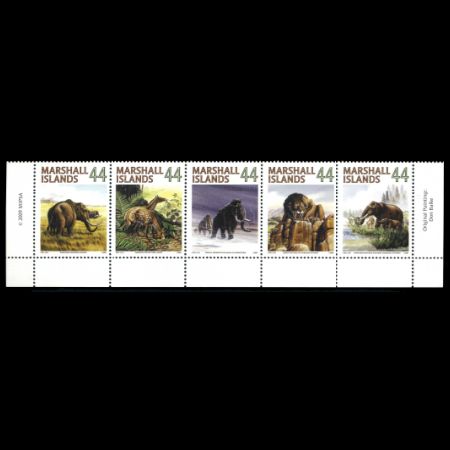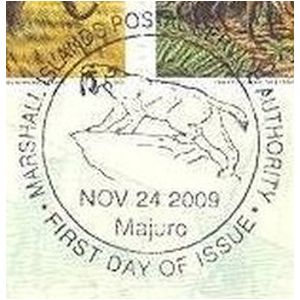Marshall Islands 2009 "Prehistoric animals"
| <prev | back to index | next> |
| Issue Date | 24.11.2009 |
| ID | Michel: 2518-2522; Scott: 956a-956e; Stanley Gibbons: 2414-2418, 2414a; Yvert et Tellier: 2439-2443; Category: pR |
| Design | D. Zoe Seemel, Artwork: Don Balke |
| Stamps in set | 5 |
| Value |
US$ 0.44 - Mastodon Roaming Prairie US$ 0.44 - Eohippus (Hyracotherium) Eating Tree Leaves US$ 0.44 - Mammoth Walking in Snowstorm US$ 0.44 - Saber-toothed Cat Perched on Rock US$ 0.44 - Mastodon Mother and Baby Drinking in Marsh |
| Emission/Type | commemorative |
| Issue place | Majuro |
| Size (width x height) |
stamps: 31 mm x 40 mm Sheet: 179 mm x 184 mm |
| Layout | Sheet of 20 (4 strips of 5 stamps) |
| Products | FDC x1 |
| Paper | unwatermarked gummed paper |
| Perforation | 13.5 x 13.5 |
| Print Technique | Black, cyan, magenta, yellow by offset lithography |
| Printed by | Printing, Cheyenne, Wyoming, U.S.A. |
| Quantity | |
| Issuing Authority | Marshall Islands Postal Service. |

On November 24th, 2009, the Marshall Islands Postal Service issued the set with five stamps showing Cenozoic's mammals. The stamps were printed in a sheet of four strips.
Between 1989 and 2018 the Marshall Islands outsource the production of their stamps to the USA-based company, Unicover Corporation (discontinued in 2018).
Unicover Corporation was privately owned, they have had a wide-reaching artwork
originals business.
Their principal subsidiary, Unicover World Trade Corporation, was markets postage
stamps in North America for various postal administrations from around the globe.
One of the subsidiary companies of Unicover was Fleetwood (acquired by Mystic in 2007).
Fleetwood was FDC maker company, since 1929, who create unique cachets for their covers,
based on the artwork collection of Unicover Corporation.
The artwork for these stamps were created in 1995, by Done Balke, for cachets of the Fleetwood's FDC with "Prehistoric Animals" stamps of USA, issued in 1996.

Don Balke grew up on a backwoods farm in northern Wisconsin, USA, where he came to love the land and its inhabitants. Appropriately, his first painting had a wildlife theme ... depicting a black bear he saw in a nearby woods. Ever since, Balke has enthusiastically and realistically painted the birds, animals and flora of North America. In 1990s and 2000s, Balke was one of the most respected wildlife artists in the United States. He captures the world he loves so much with painstaking attention to detail, and brings total realism and authenticity to his paintings. His penchant for detail makes his works sought after by nature enthusiasts, discriminating collectors, and all who appreciate and enjoy fine wildlife art. Balke's art can be found in collections everywhere, from the Vatican to the People's Republic of China. He has exhibited his work at one-man shows across the country and has been awarded Blue Ribbons at the Ducks Unlimited National Exhibit. In addition, Balke has created collections of art for the National Audubon Society and the National Wildlife Federation.
The following text was written on the reverse side of FDCs produced by the Fleetwood company in 1996, with some notes added by the author of this website.
Towards the end of the Mesozoic Era about 65 million years ago, changes began to take place on Earth, resulting in the growth of mountain ranges and a colder and more arid climate. Swamplands and shallow oceans dried up, hastening the extinction of many reptilian species. These geological and atmospheric changes prepared the way for the next age of history:
the Cenozoic Era, also known as the Age of Mammals.
During this Era, ancestors of present-day mammals including early elephants, horses and camels were originated. Carnivores proliferated and evolved into canine and feline types of animals. While some creatures adapted very well to the changing environment, others could not tolerate the new conditions and migrated to more temperate areas. Those that could not adapt eventually became extinct.
Evidence reveals that the mastodons date back 40 million years.
Originating in North Africa, they eventually migrated to Asia, Europe and the rest of Africa. Some 25 million years later, these creatures crossed the Bering Strait to North America. Mastodons became extinct approximately 8,000 years ago.
 |
 |
|
Mastodons on stamps of Marshall Islands 2009,
MiNr.: 2518, 2522; Scott: 956a, 956e.
|
|
Early male mastodons had two sets of tusks, one attached to the bottom jaw and one to the top. The lower tusks were short and straight in contrast to the long and curved upper tusks. Later, due to evolutionary adaptations, the lower tusks disappeared.
Well-preserved remains of mastodons have been found all over North and South America.
Mastodon is not a genus, but the colloquial name for members of the family Gomphotheriidae.
The depicted genus is probably Mammut.
The first Mastodon discovered in the North America was the mastodon discovered in 1799.
Some of its bones were depicted on USA's stamp
"150th Anniversary of the Pennsylvania Academy of the Fine Arts"
in 1955. This stamp is the
first stamp with a bones, skeleton of prehistoric animal.
An early ancestor of the modern-day horse, Eohippus, also known as "dawn horse" or Hyracotherium, existed about 65 million years ago in what is now North America and Europe.
 |
| Eohippus (Hyracotherium) stamp of Marshall Islands 2009, MiNr.: 2519, Scott: 956b. |
Large herds of prehistoric horses were believed to have roamed throughout North and South America, yet scientists can't explain why the early horse disappeared from the Americas between 8,000 to 10,000 years ago.
Eohippus was a small, fox-like animal with an arched back. Standing about 10 to 20 inches (25cm to 50cm) high, these early horses had four toes on their front feet and three on their hind feet. Each toe ended in a separate small hoof. Large pads, similar to those of dogs, kept the toes off the ground and bore the animal's weight.
As the horse evolved, it became taller and its legs more slender. The center toes lengthened and became stronger.
Though early man hunted horses for food, these animals were not domesticated until long after dogs and cattle. There is no evidence of when man first tamed horses and trained them for riding. However, in the ancient city of Susa in southwestern Asia there is documentation that man rode horseback more than 5,000 years ago.
It is believed that today's domestic horse breeds emerged from three types of an early horse: Przewalski's horse of central Asia, the tarpan found in south-eastern Europe and the forest horse of northern Europe.
Ancestor of the present-day elephant, the mammoth originally inhabited the temperate climate of the northern hemisphere during the glacial period.
 |
| Mammoths on stamp of Marshall Islands 2009, MiNr.: 2520, Scott: 956c. |
It is believed that these huge prehistoric beasts prospered during post-glacial times when northern Asia was covered with pine forests, supplying the mammoth with an abundance of vegetation.
Due to slow climatic changes, these forests disappeared and may be one of the reasons for the mammoth's extinction. Mammoth fossils are quite common throughout northern Europe, North America and Asia.
The ivory of this magnificent beast was so abundant that during the Middle Ages it was exported from Siberia to China and Europe.
In 1799, the first intact mammoth carcass was discovered. Frozen into icy cliffs along the Arctic coast of Siberia, this find enabled paleontologists to successfully reconstruct the mammoth's form and features. In 1801, another discovery was made in Siberia in which a complete skeleton - including entire mammoth tusks still in their sockets - had been preserved in the ice.
This specimen exhibited thick skin covered with dark, dense woolly fur, and tusks that measured over nine feet in length. Mammoth tusks are distinct from present-day elephant tusks in that they display a vast outward and upward sweep. The largest mammoth tusks on record were found in Alaska and measure nearly 13 feet (4 meter) long.
A formidable predator, the saber-toothed cat existed during the Oligocene Period, some 40 million years ago. It roamed the continents of Europe, Asia, Africa, North America and South America.
 |
| Saber-toothed cat (Smilodon) on stamp of Marshall Islands 2009, MiNr.: 2521, Scott: 956d. |
One of the most famous saber-toothed cats lived in North and South Americas was
Smilodon.
Smilodon lived in the Americas during the Pleistocene Epoch
(2.5 million years ago – 10,000 years ago).
The genus was named in 1842 based on fossils from Brazil; the generic name means
"scalpel" or "two-edged knife" combined with "tooth".
The hundreds of specimens obtained from
the La Brea Tar Pits in Los Angeles
constitute the largest collection of Smilodon fossils.
Yet this creature was distinguished by sharp, eight-inch-long, canine teeth resembling curved sabers. It was also equipped with huge jaws capable of opening to a 90 degree angle, making it easier to attack large prey.
The saber-toothed cat feasted on thick-skinned animals such as the woolly mammoth, mastodon and ground sloth.
Often compared to modern lions and tigers because of its predatory habits and its size, this creature is also referred to as the "saber-toothed tiger" and "saber-toothed lion."
Scientifically, these names are not accurate, as the saber-toothed cat is a true cat, a member of the felid family Felidae, while lions and tigers are members of sub-families of felids.
Around 8,000 years ago, the saber-toothed cat became extinct. An early theory about this phenomenon stated that the big cat's prominent teeth grew so large its bite eventually became ineffective for hunting and eating. However, scientists now believe that as the prey of the saber-toothed cat began to die out, the loss of its primary food source in turn led to the creature's own demise.
Products and associated philatelic items
| FDC | First-Day-of-Issue Postmark | |
 |
 |
|
References
 |
-
Technical details and short press releases:
Marshall Islands Stamp Catalog (this website does not exist anymore), Stampedout, colnect, -
Don Balke:
Web Archive, -
Fleetwood:
Web Archive, - Descriptions of the prehistoric animals:
The reverse side of Fleetwood's FDC with "Prehistoric Animals" stamps of USA 1996.-
Smilodon:
Wikipedia
-
Smilodon:
Acknowledgements
Many thanks to Dr. Peter Voice, PhD Department of Geological and Environmental Sciences, Western Michigan University, USA, for reviewing of a draft of this article.| <prev | back to index | next> |